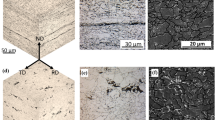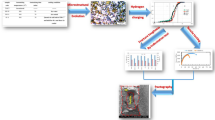Abstract
Hydrogen embrittlement has been recognized as one of major degradation mechanisms causing the decrease of ductility and fracture toughness of several kinds of materials. In accordance with the demand for hydrogen fuels, it becomes more important to ensure safety of relevant facilities like pressure vessels, storage tanks and so on. The objective of this study is to examine fracture resistance of American Petroleum Institute (API)-X70 steel under highly pressurized hydrogen gaseous condition. The extended finite element method (XFEM) was adopted to predict J-R curves via a crack growth simulation approach. At first, preliminary analyses for SM490A carbon steel were carried out to demonstrate applicability of the XFEM, of which result was comparable to test data within 14 %. Subsequently, iterative numerical analyses were conducted to calibrate appropriate damage parameters for the API-X70 steel by using notched round bar specimens. Finally, crack growth simulations of 1T-compact tension (CT) specimens were performed adopting the calibrated parameters. JIC values determined from predicted J-R curves were compared with 1/2T-CT CTOD test data and relevant constraint effect was discussed.
Similar content being viewed by others
Abbreviations
- N I (x) :
-
Nodal shape function
- u I :
-
Displacement vector
- H(x) :
-
Heaviside function
- F α (x) :
-
Crack tip function
- I, a, b, α :
-
Nodal enriched degree of freedom
- T :
-
Traction vector
- 5 :
-
Displacement segment vector
- T 0 :
-
Cohesive strength
- δ 0 :
-
Critical separation
- Γ 0 :
-
Cohesive energy
References
I. Moro, L. Briottet, P. Lemoine, E. Andrieu, C. Blanc and G. Odemer, Hydrogen embrittlement susceptibility of a high strength steel X80, Materials Science and Engineering, A (527) (2010) 7252–7260.
I. M. Robertson, P. Sofronis, A. Nagao, M. L. Martin, S. Wang, D. W. Gross and K. E. Nygren, Hydrogen embrittlement understood, Metallurgical and Materials Transactions B, 46B (2015) 1085–1103.
X. Li, J. Zhang, E. Akiyama, Q. Fu and Q. Li, Hydrogen embrittlement behavior of Inconel 718 alloy at room temperature, Journal of Mechanical Science and Technology, 35(4) (2019) 499–502.
J. Yamabe, O. Takakuwa, H. Matsunaga, H. Itoga and S. Matsuoka, Hydrogen diffusivity and tensile-ductility loss of solution-treated austenitic stainless steels with external and internal hydrogen, International Journal of Hydrogen Energy, 42 (2017) 13289–13299.
K. H. Schwalbe, I. Scheider and A. Cornec, Guidelines for Applying Cohesive Models to the Damage Behaviour of Engineering Materials and Structures, Springer, New York (2013).
F. Abbassi, F. Ahmad, S. Gulzar, T. Belhadj, A. Karrech and H. S. Choi, Design of T-shaped tube hydroforming using finite element and artificial neural networking modeling, Journal of Mechanical Science and Technology, 34(3) (2020) 1129–1138.
F. Florian and S. Michael, Experimental and numerical investigations on limit strains using an enhanced rousselier model, Engineering Fracture Mechanics, 226 (2020) 106868.
T. Belytschko and T. Black, Elastic crack growth in finite element with minimal remeshing, International Journal for Numerical Methods in Engineering, 45(5) (1999) 601–620.
R. F. Swati, L. H. Wen, H. Elahi, A. A. Khan and S. Shad, Experimental and numerical investigation of transversal damage in carbon fiber reinforced composites using X-FEM analysis, Journal of Mechanical Science and Technology, 33(1) (2019) 205–211.
ABAQUS, ABAQUS User’s Manual Ver. 2020, Dassault Systemes, Vélizy-Villacoublay, France (2020).
G. G. Youn, J. S. Kim, Y. J. Kim and M. Kamaya, Numerical prediction of notch bluntness effect on fracture resistance of SM490A carbon steel, Fatigue & Fracture of Engineering Materials & Structures, 43(4) (2020) 660–671.
T. T. Nguyen, J. Park, W. S. Kim, S. H. Nahm and U. B. Beak, Effect of low partial hydrogen in a mixture with methane on the mechanical properties of X70 pipeline steel, International Journal of Hydrogen Energy, 45 (2020) 2368–2381.
A. R. Khoei, Extended Finite Element Method: Theory and Applications, Wiley (2015).
G. Sivakumar and V. B. Maji, Simulation of crack propagation in rocks by XFEM, Proc. of the Conference on Recent Advances in Rock Engineering (RARE 2016), Atlantis Press (2016).
ASTM E1820-13, Standard Test Method for Measurement of Fracture Toughness, ASTM International, West Conshohocken, PA (2013).
ASTM G142-98, Standard Test Method for Determination of Susceptibility of Metals to Embrittlement in Hydrogen Containing Environments at High Pressure, High Temperature, or Both, ASTM International, West Conshohocken, PA (2011).
BS 7448-1:1991, Fracture Mechanics Toughness Tests — Part 1. Method for Determination of KIC, Critical CTOD and Critical J values of Metallic Materials, British Standard Institution, London, UK (1991).
ASTM G129-00, Standard Practice for Slow Strain Rate Testing to Evaluate the Susceptibility of Metallic Materials to Environmentally Assisted Cracking, ASTM International, West Conshohocken, PA (2006).
Y. S. Chang, J. M. Kim, J. B. Choi, Y. J. Kim, M. C. Kim and B. S. Lee, Derivation of ductile fracture resistance by use of small punch specimens, Engineering Fracture Mechanics, 75 (2008) 3413–3427.
C. S. Seok and S. Y. Kim, Effect of specimen configurations on the fracture resistance curve, Nuclear Engineering and Design, 214 (2002) 47–56.
Acknowledgments
This work is supported by the Korea Agency for Infrastructure Technology Advancement (KAIA) grant funded by the Ministry of Land, Infrastructure and Transport (Grant 19TLRP-C152334-01).
Author information
Authors and Affiliations
Corresponding author
Additional information
Dong-Hyun Kim received his B.S. degree from the Department of Nuclear Engineering in 2020 at Kyung Hee University. Currently he is a M.S. candidate in Kyung Hee University and his research interest is computational fracture mechanics.
Rights and permissions
About this article
Cite this article
Kim, DH., Sim, J.M., Chang, YS. et al. Hydrogen gaseous effects on fracture resistance of API-X70 estimated by XFEM. J Mech Sci Technol 35, 3829–3835 (2021). https://doi.org/10.1007/s12206-021-2106-7
Received:
Revised:
Accepted:
Published:
Issue Date:
DOI: https://doi.org/10.1007/s12206-021-2106-7




